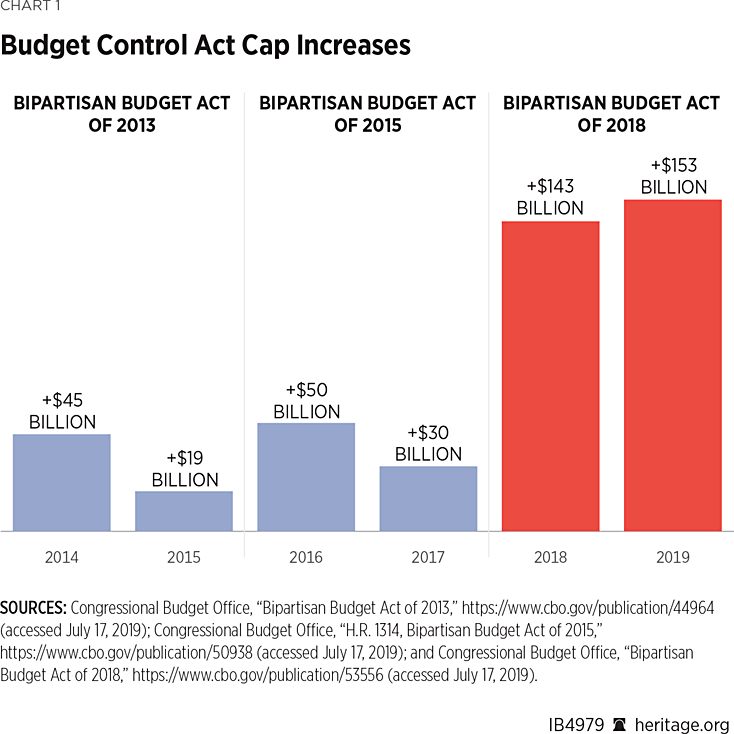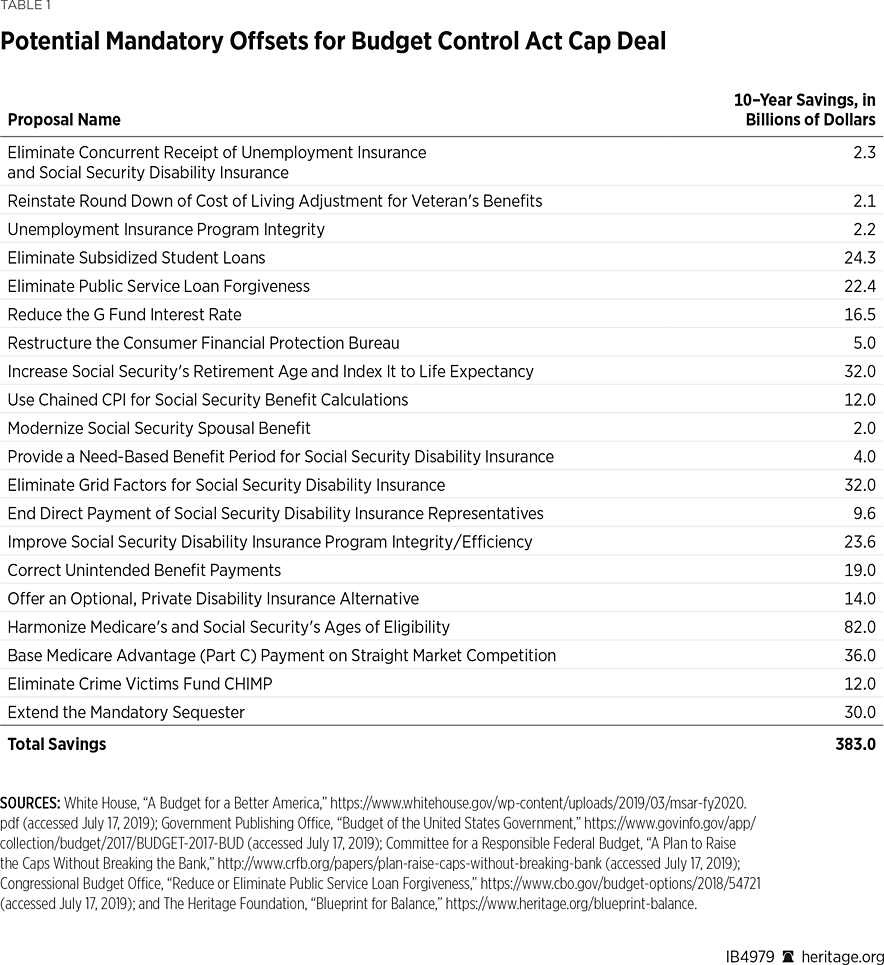Why a Budget Control Act Cap Deal Is Likely
The Budget Control Act of 2011 (BCA) was signed into law as a means to raise the debt limit by $2.1 trillion in return for at least an equal amount of spending cuts. The cuts were achieved through caps on defense and non-defense discretionary spending and automatic cuts, known as sequestration, to non-exempt mandatory programs.REF
Congress has repeatedly taken action to undermine the discretionary spending caps that the BCA established. Since 2013 lawmakers have enacted three separate “Bipartisan Budget Acts,” raising the BCA caps by a combined $440 billion over six years.REF The first two cap amendments were fully “offset,” i.e., paid for—at least on paper—although much of the savings took nearly 10 years to materialize, and some provisions were clearly budget gimmicks that would generate no real savings.REF
However, the most recent and largest of the three deals, the Bipartisan Budget Act of 2018, included only limited offsets. Of the $296 billion in new spending over fiscal years (FY) 2018–2019, less than 13 percent was paid for through spending reforms, and almost none of those cuts began until nine years after the initial spending increases.REF

The BCA’s discretionary spending caps are set to expire after FY 2021. The Bipartisan Budget Act of 2018 included such a massive spending increase that it has created a $125 billion funding cliff in FY 2020,REF all but ensuring another massive two-year cap deal.REF
The most fiscally responsible solution to the BCA cap dilemma would be for Congress to amend the law, eliminating the firewall between defense and non-defense spending. This would give lawmakers greater flexibility to appropriately fund national defense and other constitutional priorities within the existing caps. However, Congress has shown little willingness to make difficult budget choices, leading to the previous three budget deals—and in all likelihood, a fourth BCA cap raising deal.
House Democrats have already put forth a plan to do just that. The “Investing for the People Act of 2019” would increase spending by $356 billion over the next two years.REF It includes no offsets for the new spending. The long-term debt impact of such an increase could be trillions of dollars.REF
Congress should follow the federal budget process and carefully prioritize taxpayer dollars toward constitutional responsibilities, i.e., national defense. Raising the spending caps lets lawmakers off the hook from budgeting within reasonable constraints.REF If Congress does pursue a BCA cap raising deal, it must ensure than any new spending is fully offset by immediate mandatory spending reforms.
What Is a Legitimate Offset?
To responsibly pay for new spending, Congress must use legitimate offsets that produce measurable budget savings over the next decade. Just as the new spending will start in FY 2020, savings should start being realized in 2020 as well. Reform proposals should be targeted toward mandatory spending programs. They should not include burdening American taxpayers with new taxes or fees. Acceptable offsets include:
-
Prioritize defense spending within the existing aggregate cap. As mentioned above, the best way for Congress to pay for a Budget Control Act cap amendment would be to increase defense spending to an appropriate level by prioritizing funding within the existing cap. The Heritage Foundation’s Blueprint for Balance recommends base defense funding of $697 billion and $742 billion total in FY 2020, while keeping total discretionary spending $40 billion below the BCA cap.REF
-
Extend BCA mandatory sequestration. Another potential offset would be to continue the Budget Control Act’s mandatory sequestration, which was used to pay for some of the additional discretionary spending in the three previous budget deals.REF However, it is important to note that while sequestration can generate real savings, it is an arbitrary across-the-board cut. It does not fundamentally fix problems with the underlying programs.
An extension of the mandatory sequester could also fall into the “spend now, save later” category mentioned later in this paper and entail significant interest costs as well as uncertainty. Sequestration, currently set to end in 2027, would likely be extended through 2029. While these cuts have generally been accepted and allowed to take place by lawmakers, the possibility remains that the cuts could be reversed before 2029.
-
Create immediate mandatory spending reforms. The best way to offset the costs of a budget deal would be through immediate mandatory reforms. While the discretionary portion of the budget is important, it comprises only one-third of total federal spending. Most of the growth in federal spending is being driven by auto-pilot mandatory programs, meaning they are not subject to congressional appropriation each year.
The biggest components of auto-pilot spending are Social Security, Medicare, and Medicaid. In just 22 years these programs, combined with interest on the national debt, are projected to consume all federal revenues.REF They are unsustainable in their current state, and reforming these programs is the key to stabilizing the debt over the long term.
The Heritage Foundation’s Blueprint for Balance outlines $338 billion in mandatory spending reforms that could be implemented in 2020. If these programmatic changes were implemented by lawmakers, they would not only pay for a BCA cap deal but put the federal budget back on a path to sustainability.
Table 1 lists a number of immediate reforms that Congress should consider for offsets in the context of a BCA cap deal. It is not an exhaustive list of all acceptable options but rather one approach lawmakers could take. Some of these proposals have garnered bipartisan support in the past, appearing in budget proposals by both President Donald Trump and President Barack Obama. Others represent recommendations from The Heritage Foundation’s latest Blueprint for Balance, which provides a path to balancing the budget within 10 years and significantly reducing the national debt.

What Is a Gimmick or Inappropriate Offset?
Not all offsets are equal. Far too often, Congress has relied on budget gimmicks, accounting tricks, and inappropriate revenue measures to “pay for” new spending. Examples of inappropriate offsets include:
-
Spend now, save later. According to the Congressional Budget Office, the Bipartisan Budget Act of 2015 cut mandatory spending by $47 billion over 10 years. More than 86 percent of those cuts were not realized until the 10th year of the budget window.REF Nearly all of the Bipartisan Budget Act of 2018’s spending cuts occurred in the last two years of the budget window.REF
Congress should not pair immediate spending increases that are guaranteed with offsets that are vague and have an uncertain likelihood of ever materializing. Such a policy increases debt in the short and long term, driving up interest payments, which are usually not accounted for when calculating the costs of legislation. Such interest costs must also be factored in.
-
Timing shifts. Timing shifts are a gimmick commonly used by Congress to “pay for” new spending. In reality, these shifts merely move numbers around on paper. Timing shifts change the year in which a revenue or expense is reported. For example, by changing a payment date from October 1 to September 30, Congress can shift revenues from the 11th year of the budget window to the 10th year. For scoring purposes, this appears to be an offset; in reality, the payment was merely sped up by one day.REF
One example of the timing-shift gimmick is from the 2013 “doc fix” package, which delayed a looming cut to Medicare physician payments. To pay for a portion of the extension, Congress shifted Medicaid savings achieved through the Bipartisan Budget Act of 2013. About $2.1 billion of these savings carried over into 2024, outside the 10-year budget window. When it came time to pass the “doc fix,” however, Congress shifted those savings from 2024 back into 2023 to help pay for the plan.REF
-
Extension of user fees. Customs user fees were established in 1985 as a means to pay for inspection services performed by the U.S. Customs Service. They originally expired in 1989 but have been extended on numerous occasions. The fees have gone from paying for legitimate needs to funding wholly unrelated spending. The Bipartisan Budget Act of 2018 included $8.5 billion in savings from a two-year extension of customs user fees.REF
If these fees are no longer necessary, then those savings should be passed on to travelers, not used to pay for more domestic spending. As it is, Congress simply renews a permanent policy to claim temporary savings time and time again.
-
Asset sales. Another popular offset has been to sell off government assets such as the Strategic Petroleum Reserve (SPR) and spectrum pipeline. The Bipartisan Budget Act of 2015 assumed $5.5 billionREF in offsets from SPR sales, and the Bipartisan Budget Act of 2018 assumed another $6.4 billionREF (at unrealistically high prices) to help pay for increases to discretionary spending. Spectrum pipeline sales have been used in a similar manner.
Selling off these assets is generally good policy; however, revenues should go toward deficit reduction, not additional spending, and Congress should not assume unrealistic returns from sales that fail to reflect market prices.
Why Offsets Are a Must
The United States government is deeply indebted, with more than $22 trillion in gross national debt—and it is projected to add more than $10 trillion in the coming decade.REF The spending decisions that lawmakers make today will affect younger and future generations the most, saddling them with a higher share of the debt and diminishing young Americans’ chances of enjoying a similar or better life than their parents and grandparents.REF
For the sake of our nation’s future, Congress must get the federal fiscal house in order. The first step is ensuring that any BCA cap deal is fully paid for (including interest costs) by implementing meaningful and immediate reforms to mandatory spending programs. Beyond the short term, lawmakers should implement fiscal restraints that will slow the growth of entitlement spending, the main drivers of spending growth. This could be achieved through a cap on all non-interest spending.
Putting the federal budget on a path to balance and reducing federal debt growth will help to secure a more prosperous future for the country and its people.
Justin Bogie is Senior Policy Analyst in Fiscal Affairs in the Grover M. Hermann Center for the Federal Budget, of the Institute for Economic Freedom, at The Heritage Foundation.


